Sweet (Bulgarian) peppers are grown in greenhouses everywhere, except in the far north, where they do not have enough heat for growth and fruiting. But even in greenhouse conditions, peppers must be properly cared for, otherwise you won’t get a good harvest.
About growing pepper seedlings at home written in detail here
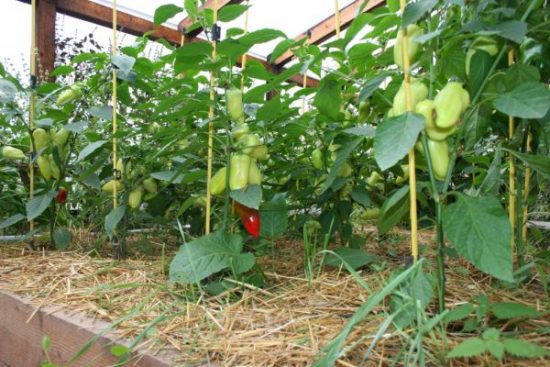 Technology for growing sweet peppers in a greenhouse |
First, an interesting film about growing bell peppers:
Conditions for growing peppers
Pepper is a southern crop, so it grows and develops well at soil temperatures of 18-25°C and air temperatures above 23°C. When the temperature drops to 15°C, the culture stops growing, and at 5°C it dies. With the onset of prolonged cold weather, bell peppers stop growing, which subsequently leads to a delay in development and fruiting for 20 days or more.
This often happens in the central regions, when after planting seedlings in a greenhouse and the onset of cold weather, the crop does not grow, and later there is a severe crop shortage. In very cold summers there is no harvest at all.
The root system of peppers grown from seedlings is fibrous and is located in the top layer of soil at a depth of no more than 25 cm. Therefore, the plants are loosened very carefully, since they are sensitive to damage to the roots.
Pepper is very light-loving, so choose the sunniest place to grow it. In shading or prolonged cloudy weather, the flowers and fruits of bell peppers fall off, the leaves turn yellow, and the stems become brittle.
The culture does not tolerate the slightest drying out of the soil. With irregular watering (especially in combination with temperatures in the greenhouse above 35°C), the bushes stop growing and the fruits become ugly.Although the bushes themselves withstand drought well, and without ovaries and fruits they can withstand a week without watering in hot weather.
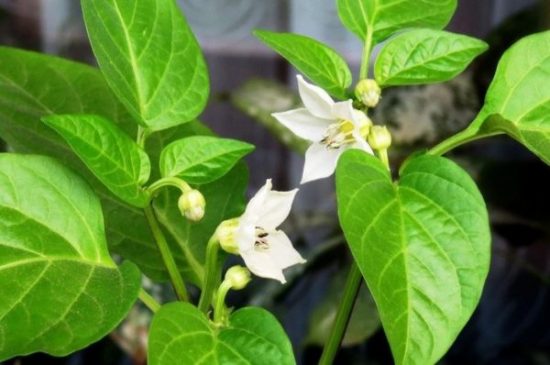 At high temperatures in the greenhouse, pollen from peppers becomes sterile |
Sweet pepper flowers form one at a time. When fruits set and ripen, the appearance of new flowers slows down, so mature fruits, and in the central regions and to the north, fruits of technical ripeness, are collected. At temperatures above 30°C, the bushes grow actively, but the pollen becomes sterile and ovaries do not form.
At temperatures above 35°C, the bushes shed flowers and ovaries.
At the beginning of the growing season, peppers grow slowly in the greenhouse. The first true leaf appears after 20-25 days under unfavorable conditions (lack of heat and light), and after 7-10 days under favorable conditions. 50-60 days after the appearance of the true leaf, buds are formed, and 15-20 days after this, flowering begins.
Sweet pepper varieties
According to the type of growth and branching, all peppers are divided into indeterminate and determinate.
Indeterminate varieties - These are tall bushes that branch heavily. Suitable for growing in southern regions. In the middle zone and to the north, as a rule, they are not cultivated because they do not have time to produce a harvest.
Determinate varieties weakly branched, compact in appearance, stunted.
By purpose There are varieties for salad and for preservation. The purpose of the variety is determined by the wall thickness. Thin-walled varieties are considered to be those with a wall thickness of up to 3 mm, and thick-walled varieties above this. This indicator can vary significantly depending on the weather and agricultural technology, as well as the growing region. In the middle zone, peppers are always thinner-walled than in the south.
Thin-walled varieties:
- Gift from Moldova
- Hedgehog
- Morozko
Thin-walled varieties also include varieties with long cone-shaped fruits (usually such peppers are called capsicums). In addition to fresh consumption, they are used to produce paprika.
Large-fruited sweet peppers with large fruits of various shapes are called vegetable peppers. The shape of the peppercorns is cubic, cylindrical, round, cone-shaped, and the walls are thick.
Thick-walled varieties are used for preservation:
- Gladiator
- Yenisei
- Chocolate
- Father Frost.
According to ripening time varieties are divided into early and mid-early, mid-ripening and late-ripening.
In early and mid-early varieties, 110-120 days pass from the appearance of true leaves to the start of harvest.
- Othello
- Health
- Medal
- California miracle
- Western (very early)
Mid-season - from germination to technical ripeness 130-140 days
- Tenderness
- Ilya Muromets
- Alesha Popovich
- Alyonushka F1
Late-ripening varieties have a ripening period of more than 140 days
- Gladiator
- Paris
- Black cardinal
In the north and central region, only early and mid-early varieties of sweet peppers are grown in greenhouses. The rest do not have time to bear fruit.
Cultivating hybrids is also not recommended, since they require higher temperatures for growth and development. In the middle zone, it is very hot in a greenhouse during the day, but at night the temperature difference can be 10-15°C, which hybrids really don’t like and drop flowers and ovaries.
In the southern regions, peppers of all ripening periods are grown in greenhouses.
Predecessors
All greenhouse crops are unsuitable predecessors for peppers.
It is extremely undesirable to grow peppers in one place for two years in a row, since the incidence of diseases increases sharply, and in general peppers do not tolerate their root secretions well and the result is a severe crop shortage.
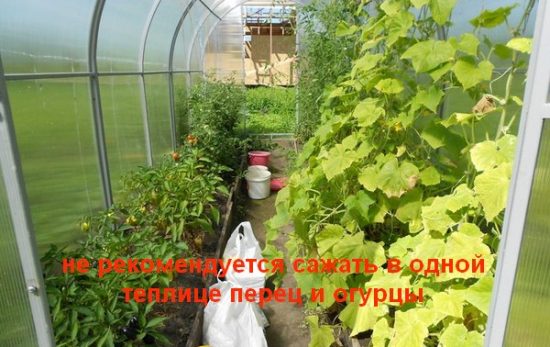 Peppers find it difficult to find neighbors to grow in a greenhouse |
It is not advisable to grow peppers together with cucumbers - they can become infected with the cucumber mosaic virus. It is better to plant it after eggplants and grow it in the same greenhouse with them or with tomatoes.
Soil preparation
Among greenhouse crops, pepper is second only to cucumbers
The most suitable for growing peppers in greenhouses are light, fertile soils with a high humus content. On acidic podzolic soils, pepper grows poorly and no more than 3-4 fruits can be collected from a bush per season. The most suitable soils for it are those with a pH of 5.5-6.5 and a high humus content.
Since it is impossible to carry out a crop rotation suitable for the crop in a greenhouse, the soil is filled with fertilizers to the maximum.
- In the fall, add 1-2 buckets per m2 half-rotted manure or 3-4 buckets of humus.
- You can bring food scraps into the greenhouse: banana skins, pear and apple carrion, sunflower husks, etc.
- Potato peelings should not be added, since peppers are affected by late blight, although not as severely as tomatoes.
- On acidic soils, lime fertilizers are applied (300-400 g per m2) or ash 1-2 cups per m2.
- If there are a lot of egg shells, you can use them after grinding them into powder.
- In the fall, phosphate fertilizers are also applied - 30-40 g of simple superphosphate per m2.
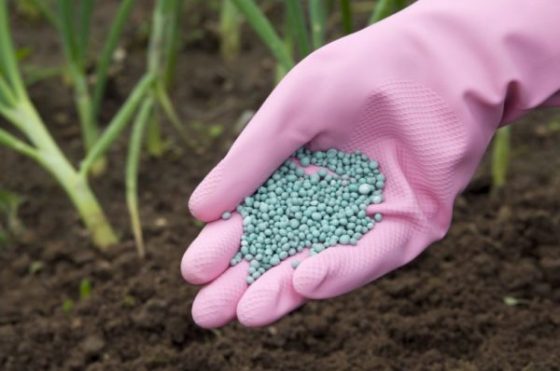 In the spring, when digging the soil or directly into the holes, add 20-30 g of potassium sulfate and, if manure or humus was not added, then urea or ammonium nitrate 1 tbsp. to the hole. |
If manure was used, then nitrogen fertilizers are not applied, since if there is an excess of them, the above-ground part of the bushes develops strongly to the detriment of fruiting: in the middle zone, with an excess of nitrogen, it may not occur; in the south, fruiting is delayed for 20-30 days.
Planting pepper seedlings in a greenhouse
In a greenhouse, there are always significant fluctuations between day and night temperatures, and peppers that previously grew in more even conditions are hardened off before planting. It is taken out to the balcony or into a greenhouse if the temperature there is not lower than 16°C, bringing it into the house only at night.
 Sweet pepper seedlings are planted when the soil warms up to 18-20°C, and the temperature in the greenhouse at night is not lower than 18°C. |
The pepper should be well formed and have at least 5 true leaves, and ideally 8-10 leaves with buds. Planting is carried out depending on the weather. In the central regions, they are usually planted in greenhouses after May 15-20, in the south - from mid-April to the end of the month.
Landing pattern
Tall varieties are planted in 2 rows with a distance between rows of 40 cm, and between plants 30 cm. If the bushes are very tall, then the distance between them is increased to 50 cm.
Low-growing varieties are planted in 3 rows with a distance between rows of 30 cm, and between bushes 20 cm. This density is due to the fact that pepper bears fruit better in thickened plantings, but there is no need to thicken it too much, since this is a favorable environment for the development of diseases.
Low-growing varieties can be planted between tall plants as a seal. Peppers can also be planted in a checkerboard pattern with a distance of 30-35 cm between short plants and 50 cm between tall plants.
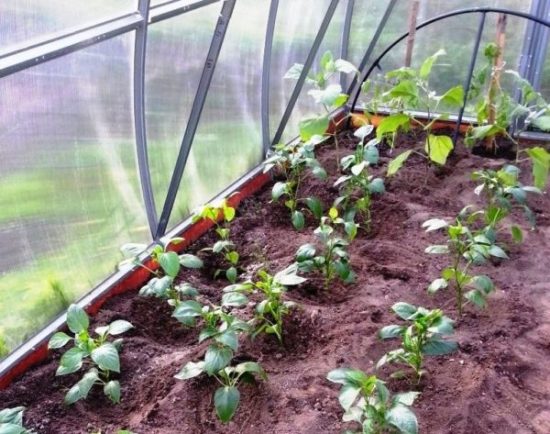 Low-growing varieties can be planted quite densely |
In the south, tall, late-ripening peppers are grown; their height can reach 2.5-3 m. Such bushes are grown on trellises and shaped. These varieties are planted at a distance of 40 cm from each other, and the row spacing is 80-90 cm.
Rules for planting pepper seedlings in a greenhouse
It is better to plant pepper seedlings on a cloudy day, and in sunny weather - in the late afternoon. Dig holes 15-20 cm deep, spill them with warm water and plant the seedlings together with a lump of earth, without deepening it. When buried, plants spend up to 10 days forming new roots and do not begin to grow. Only very overgrown elongated seedlings can be buried by 3-4 cm.
The soil around the stem is pressed tightly. To reduce evaporation, the ground around the bush is sprinkled with dry soil, humus, or peat on chernozems (on acidic soils, peat is not used as mulch, since it increases acidity).
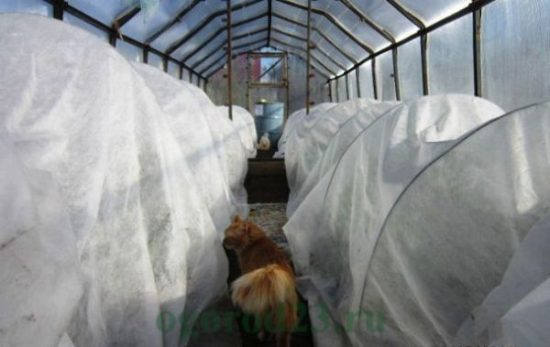 When it gets cold, sweet pepper seedlings are even covered in a greenhouse |
If there are strong fluctuations in day and night temperatures, seedlings are additionally insulated with straw and covered with spunbond or film.
There is no need to be afraid that the pepper will burn; Seedlings grown at home are more likely to suffer from cold than from too high temperatures. Under covering material, young bushes quickly adapt to greenhouse conditions.
Young peppers are very sensitive to the bright spring sun and often get burned.
Some plants die from them. To avoid this, the planted seedlings are covered with spunbond or plastic transparent bottles. After a few days, the plants will get used to the sun and the covering material is removed.
Pepper care before flowering
Before flowering, pepper care consists of regular watering, fertilizing, loosening and ventilation of greenhouses.
Loosening
The bushes are loosened very carefully, since the bulk of the roots are in the surface layer of soil, and peppers are very sensitive to damage to large roots, slowing down growth. Therefore, they only loosen the row spacing and very shallowly at a distance of 10-15 cm from the stem. To maintain soil moisture, the ground is mulched with rotted sawdust.
Watering
Watering is carried out depending on the weather. Sweet peppers in a greenhouse do not tolerate the slightest drying out of the soil or waterlogging. In hot sunny weather, watering is carried out once every 5-7 days, in cold and cloudy weather - no more than 1 time in 10 days. The water should be warm (not lower than 20°C). Before the crowns close, the soil is loosened a day after watering.
Feeding
10 days after planting the seedlings, the bushes are fed. During this period of growth, pepper in the greenhouse most of all needs phosphorus for the formation of roots, nitrogen for the growth of green mass and microelements.
For the first feeding You can use organomineral fertilizers Krepysh, Malyshok, slurry or grass infusion.
The infusion and slurry are taken in the proportion of 1 glass per bucket of water (bird droppings 0.5 glasses per 10 liters of water). Microfertilizers for tomatoes and peppers, which do not contain nitrogen, and simple superphosphate (2 level tablespoons) are dissolved in it. Watering is carried out at the root so that water does not fall on the leaves.
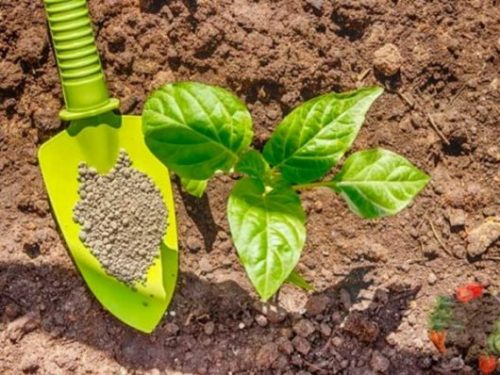 In the absence of organic matter, peppers are fed with mineral fertilizers: simple superphosphate, which additionally contains magnesium and sulfur, and urea (2 tbsp/10 l of water). |
Then before flowering begins fertilizing is carried out once every 10 days, using only mineral fertilizers and reducing the dose of urea to 1/2 teaspoon.
If the pepper does not bloom for a long time, then it was overfed with nitrogen. In this case, abundant watering is done, leaching nitrogen compounds into the lower layers of the soil, where they will be inaccessible to the roots.
In the next feeding add 1 tsp potassium sulfate, microfertilizers without nitrogen and 20 g of superphosphate. Further, until the beginning of flowering, nitrogen is not used. The feeding rate is 5 liters per plant.
Ventilation of greenhouses
Ventilation of the greenhouse when growing peppers is carried out daily in any weather. Even on very cold days, open the windows for 10-15 minutes.
Formation of peppers in a greenhouse
Peppers do not form. But there are some very tall varieties that require shaping. They are grown only in the south in greenhouses on a trellis.
After 8-10 true leaves appear, the bushes begin to branch. They have 3-5 side shoots of the first order. Of these, 1-2 of the strongest are selected, the rest are cut out after the first sheet. Second-order shoots soon appear on these shoots, one of which is selected, and the rest after the first leaf are also plucked out. Each shoot is tied to a trellis separately. With shoots of the 3rd and subsequent orders, do the same.
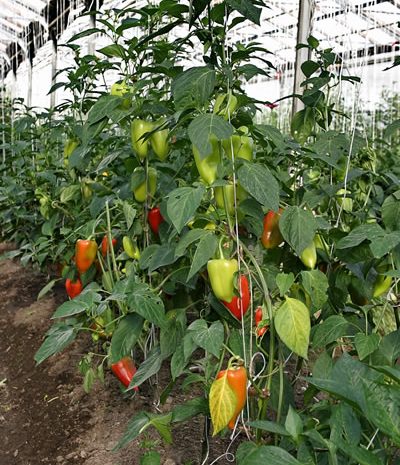 The formation of peppers is the exception, not the rule, and it applies to a small number of varieties. |
Varieties whose height does not exceed 1.5 m are grown without formation. The only thing you need to do is remove the yellowed leaves.
Care during flowering and fruiting
Carry out long-term ventilation of the greenhouse. At temperatures above 30°C, pollen becomes sterile and pollination does not occur. At high humidity and temperature, the bushes shed flowers.
Watering is carried out depending on the weather. Determine soil moisture by placing your hand on the ground.If it is wet to the touch, but does not stick to your hand, then water it. In the middle zone they water once every 4-7 days, in the south in hot weather they water once every 3 days. With irregular watering, flowers and ovaries fall off. Watering is carried out only with warm water.
After flowering begins, the composition of the fertilizer also changes. For 10 liters of water take 1 glass of ash or 20 g of potassium sulfate. On poor soils, 1/2 tablespoon of urea is added to every second fertilizing. or 1/4 cup green fertilizer. On chernozems, nitrogen fertilizers may not be applied during this period. In addition to them, microfertilizers are added to any fertilizer. Phosphorus is not required by plants during this period and is no longer used.
For prevention blossom end rot Once a month, starting from the moment the ovaries appear, the bushes are sprayed with calcium nitrate or Vuksal Ca. For large-fruited peppers, the fertilizing rate is increased by 1.5 times.
It is also advisable to foliar fertilize once a month with microfertilizers “for tomatoes and peppers.” Proper fertilizing with phosphorus-potassium fertilizers inhibits the appearance of rot, especially root rot, as well as stolbur and verticillium.
Non-flowering shoots are regularly cut out from the bushes, and fruit-bearing shoots are tied up to prevent them from lodging and breaking off the stems.
 It is advisable to tie each fruiting stem separately so that the bush will not be too dense and the risk of disease will be reduced. |
When growing sweet peppers in greenhouses on peat or sandy soil during the fruiting period lower leaves turn yellow and curl, their edges dry out, but the veins remain green, and watery spots appear on the peppercorns. The shoots become woody, especially at the bottom up to 3-5 leaves, the plant itself seems to dry out.
This is a lack of potassium.The crop is urgently fed with potassium fertilizers (20 g/10 l). Before the peppers acquire a normal appearance, do not add magnesium and calcium, which interfere with the absorption of potassium.
Harvest
Pepper is a very “leisurely” crop and technical ripeness occurs 30-40 days after the appearance of the ovaries, and only 20-30 days later does biological (seed) ripeness occur.
The harvest of bell peppers is harvested in the technical ripeness phase, when the fruits acquire the color characteristic of the variety (white, light or dark green, yellowish), peppery aroma and sweet taste. In the technical ripeness phase, the seeds are immature and unsuitable for sowing.
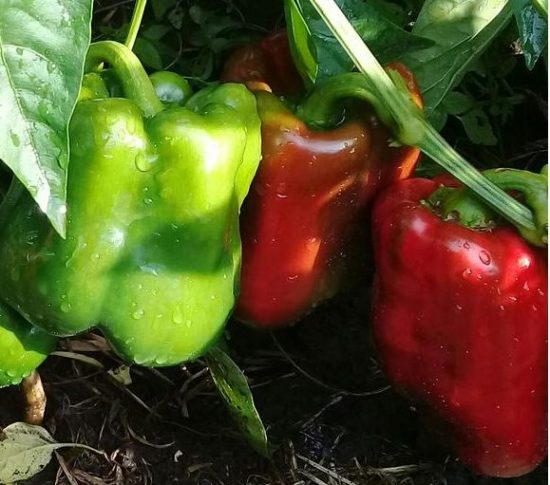 Sweet bell peppers are cut off, and small-fruited varieties are broken off. Since they have a thin stalk, breaking off the fruit does not damage the plant. |
Paprika is removed only when the peppercorns are biologically ripe, when they acquire a characteristic color and begin to dry out. The peppercorns are removed and dried.
Fruits of technical ripeness are harvested many times, usually once a week. Regular harvesting of fruits leads to an increase in yield and a decrease in ovary abscission. As soon as the peppercorns are picked from the bush, the ovaries begin to grow rapidly and new flowers appear.
The harvested crop can be stored for up to 2 months. During this time, the peppercorns will reach biological ripeness and the seeds will be suitable for sowing
Fruits in biological ripeness are harvested as they ripen.
Difficulties and problems when growing peppers in a greenhouse
Pepper is a much more demanding crop than tomatoes. In the northern regions there are many problems with them, in the south - much less.
Pepper doesn't bloom. Excess nitrogen fertilizers in fertilizing.Nitrogen is excluded from fertilizing and the dose of potassium and microelements is increased.
The pepper is blooming in the greenhouse, but there are no ovaries on it. Temperature and humidity too high. The greenhouse must be ventilated regularly, and if the nights are warm, it should not be closed.
Ovaries do not appear even during severe cold weather or sudden changes in day and night temperatures. To correct the situation, the plants are additionally covered with lutrasil or insulated with straw. To increase the crop's resistance to unfavorable conditions, it is sprayed with the biostimulants Bud or Ovary.
Shedding of flowers and ovaries. In the northern regions, the culture simply lacks nutrition. Sweet peppers are very demanding on soil fertility and, if there is a lack of nutrients, they will shed flowers, ovaries and even fruits. Fertilizing does not fully provide it with the required rate of consumption of elements. The only way to reduce the fall of the ovaries is to apply manure in the fall and regular fertilizing with potassium-phosphorus fertilizers during the growing season.
In the south, shedding of buds and ovaries occurs due to too dry soil. Bell pepper does not even tolerate drying out of the soil and this must be strictly monitored.
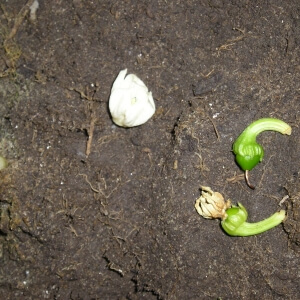 The ovary falls off from the pepper |
The high nitrogen content in the soil encourages the plant to shed flowers and ovaries and build up green mass. Therefore, at the beginning of fruiting, the dose of nitrogen is greatly reduced, and fertilizing with organic matter at this time is generally prohibited.
The reason for the shedding of flowers and ovaries can be prolonged cloudy weather, and although it may be warm in the greenhouse, pepper needs the sun to form a harvest. In its absence, no fertilizing will help; the bushes will still shed their ovaries.
Leaves rise vertically and acquire a purple tint - a lack of phosphorus.Increase the dose of phosphorus in fertilizing.
Leaves curl upside down, sometimes their border takes on a brown tint - a severe lack of potassium. Spray with potassium sulfate, and pour a glass of ash under the root and embed it in the soil.
Yellowish-green spots appear on older leaves, later becoming brown - lack of zinc. Spray with any microfertilizer that contains zinc. The difference between a deficiency of an element and a disease is that the spots do not spread across the leaf, do not increase in size, or rot.
Plants stopped growing after planting seedlings. They are too cold. Even if the greenhouse is warm enough, it is stressful for the crop, especially with strong fluctuations in day and night temperatures. No matter how hardened the pepper was, it came from the “sanatorium” to harsh conditions. Therefore, in the first few days it is additionally covered with spunbond, opening it during the day. When ventilating the greenhouse, the spunbond does not need to be removed.
Continuation of the topic:
- Pepper diseases in greenhouses and open ground
- Growing cucumbers in a greenhouse
- Planting tomatoes in a greenhouse and open ground
- Tomato diseases photo and treatment
- How to grow peppers outdoors in different regions
- Why do bell pepper leaves turn yellow?
- What to do if pepper leaves begin to curl
- How to properly water and fertilize peppers
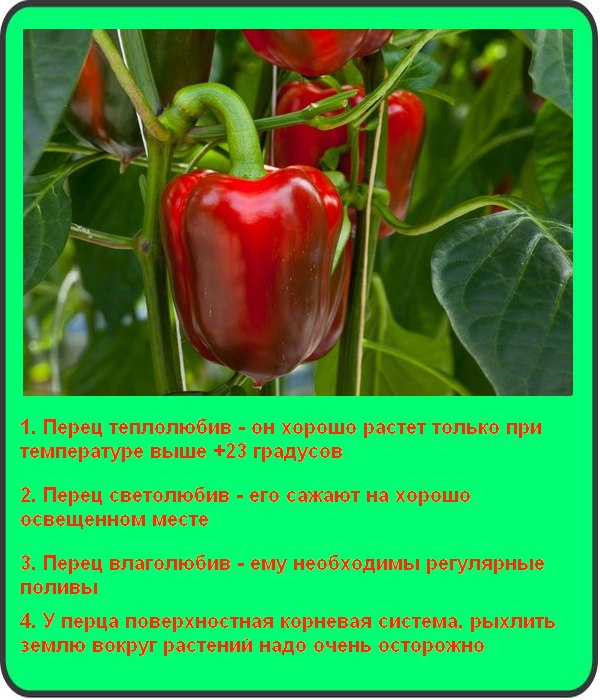
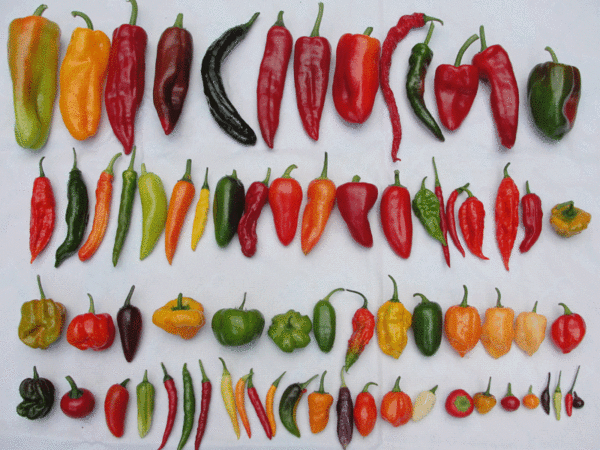


 (8 ratings, average: 4,38 out of 5)
(8 ratings, average: 4,38 out of 5) CUCUMBERS NEVER GET SICK, I'VE BEEN USING ONLY THIS FOR 40 YEARS! I SHARE A SECRET WITH YOU, CUCUMBERS ARE LIKE THE PICTURE!
CUCUMBERS NEVER GET SICK, I'VE BEEN USING ONLY THIS FOR 40 YEARS! I SHARE A SECRET WITH YOU, CUCUMBERS ARE LIKE THE PICTURE! You can dig a bucket of potatoes from each bush. Do you think these are fairy tales? Watch the video
You can dig a bucket of potatoes from each bush. Do you think these are fairy tales? Watch the video
 How our fellow gardeners work in Korea. There is a lot to learn and just fun to watch.
How our fellow gardeners work in Korea. There is a lot to learn and just fun to watch. Eye trainer. The author claims that with daily viewing, vision is restored. They don't charge money for views.
Eye trainer. The author claims that with daily viewing, vision is restored. They don't charge money for views. A 3-ingredient cake recipe in 30 minutes is better than Napoleon. Simple and very tasty.
A 3-ingredient cake recipe in 30 minutes is better than Napoleon. Simple and very tasty. Therapeutic exercises for cervical osteochondrosis. A complete set of exercises.
Therapeutic exercises for cervical osteochondrosis. A complete set of exercises. Which indoor plants match your zodiac sign?
Which indoor plants match your zodiac sign? What about them? Excursion to German dachas.
What about them? Excursion to German dachas.